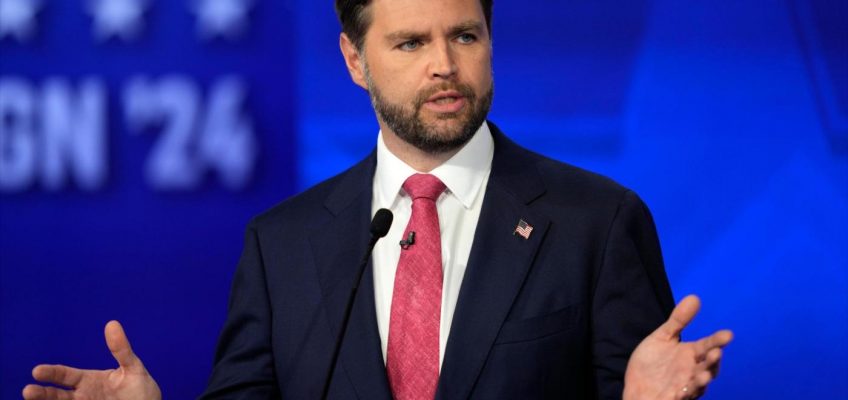By MELISSA GOLDIN
Republicans, including former President Donald Trump, have recently claimed that hundreds of thousands of migrant children who crossed the U.S.-Mexico border unaccompanied are missing, then criticized the border policies of the Biden administration and Democratic presidential nominee Vice President Kamala Harris.
Ohio Sen. JD Vance, the Republican vice presidential nominee, repeated the claim during Tuesday night’s debate.
“We have 320,000 children that the Department of Homeland Security has effectively lost,” he said as he met Minnesota Gov. Tim Walz in what is likely the last debate of the 2024 presidential campaign.
But immigration experts say the claims regarding missing migrant children lack significant context.
Here’s a closer look at the facts.
CLAIM: The Biden administration has lost more than 300,000 unaccompanied migrant children.
THE FACTS: This claim misrepresents information in an August report published by the Department of Homeland Security’s Office of the Inspector General, which faulted Immigration and Customs Enforcement for failing to consistently “monitor the location and status of unaccompanied migrant children” once they are released from federal government custody.
The report noted that more than 291,000 unaccompanied migrant children had not, as of May 2024, received a notice to appear in court. Additionally, more than 32,000 unaccompanied migrant children got a notice to appear but then failed to show up for immigration court hearings. Those figures came from ICE and covered a period from October 2018 to September 2023. During that period there were a total of 448,820 unaccompanied children released by ICE to the Department of Health and Human Services’ Office of Refugee Resettlement.
But experts say it is a stretch to refer to roughly 300,000 children as “lost” or “missing.”
“This is not a ‘missing kids’ problem; it’s a ‘missing paperwork’ problem,” Jonathan Beier, associate director of research and evaluation for the Acacia Center for Justice’s Unaccompanied Children Program, wrote in an email.
Plus, President Joe Biden only entered the White House partway through this period. It includes approximately 15 months when Trump was president and does not specify how many children arrived in the U.S. under each president.
Experts say there are many reasons why the children might not have appeared for hearings or received a notice to appear in the first place. For example, they only get a notice to appear when removal proceedings against them have begun, and if ICE hasn’t started that removal process, they wouldn’t have gotten a notice in the first place.
A lack of communication between government agencies could mean a notice is sent to the wrong address if it has been updated with one agency and not another. A child’s guardian may be unable to take them to court, perhaps because they live on the other side of the state.
The report does not provide any explanations.
“All of these factors can explain some of the deficiencies and a conclusion that the children are missing could be very, very premature,” said Raul Pinto, deputy legal director for transparency at the American Immigration Council.
Cybersecurity head says there’s no chance a foreign adversary can change US election results
The president could invoke a 1947 law to try to suspend the dockworkers’ strike. Here’s how
Prosecutors: Trump ‘resorted to crimes’ after losing 2020 election in failed bid to cling to power
Alaska resource projects and landscapes are again in the crosshairs of a presidential election
‘The white-hot laser of hate’ is trained on Springfield, Ohio. How long will it last?
Carmen Hills, an ICE spokesperson, said the agency agreed with the inspector general’s recommendations to improve information sharing within ICE and externally with HHS, but disagreed with the suggestion that the children are missing.
“We are concerned that the report’s findings are misleading and may be misconstrued because they fail to acknowledge key facts,” she said.
Hills said ICE does not generally issue court notices to unaccompanied children “until after they have been placed with sponsors who have been vetted by HHS” so that they can get settled and seek legal help.
Representatives for HHS and Vance did not respond to requests for comment from The Associated Press.
An unaccompanied migrant child is defined by the U.S. government as someone who is under 18, lacks lawful immigration status and has no parent or guardian in the country to take custody of them. When they’re apprehended by the Department of Homeland Security, they’re transferred to the HHS’s Office of Refugee Resettlement.
They are then placed “in the least restrictive setting that is in the best interests of the child,” according to the resettlement office. That can mean shelters, foster care or residential treatment centers, among other options. If possible, children are released to sponsors, often family members, who can care for them.
Removal proceedings may be initiated by ICE and the Department of Justice. Some children are able to stay in the U.S. legally if they qualify for asylum, special visas for victims of abuse, trafficking and other crimes, or other types of immigration relief. In those cases, removal proceedings may never start.
___
Find AP Fact Checks here: https://apnews.com/APFactCheck.




